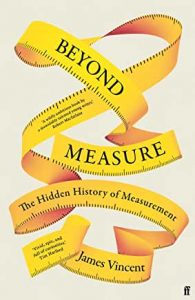Beyond Measure: The Hidden History of Measurement by James Vincent had the good fortune to be published more or less when the Johnson government here decided a good wheeze to distract voters’ attention from – well, everything – would be to launch a consultation on the reintroduction of imperial measures alongside metric. The recent by-election results suggest the wheeze failed; maybe the population just isn’t overwhelmed with excitement by the subject of measurement standards.
I am of course one of the minority who does find measurement an unbelievably exciting subject, and I enjoyed reading the book. It uses a chronological structure to explore different aspects of measurement, starting with the ancient world and the emergence of standard measures for trade, moving on to early modern states, the Scientific Revolution and French Revolution, with a separate chapter on early statistics, and ending up indeed with a chapter subtitled “Metric vs imperial and metrology’s culture war” and finally measurement today (including the concept of the ‘quantified self’.
I quite like this summary of the purpose of measurement: “From the ancient world onwards, measurement has been embraced not only for its practical benefits – for its utility in tasks like construction and trade – but also for its ability to create a zone of shared expectations and rules; to mediate our experience with the world and one another, ensuring that the interactions between two strangers who live under the same set of measures can be validated and trusted.” This purpose of mutual benefit sits alongside the use of measurement by rulers and states – and the book indeed cites classic authors like James Scott and Theodore Porter.
Although books such as the wonderful Seeing Like A State, or more recent ones on specific areas of measurement such as Andrew Whitby’s recent The Sum of The People about the history of the census, obviously have a lot more detail than the chapters here, Beyond Measure delivers on its aim of providing an accessible overview of the history of measurement and many of the issues of meaning. It’s a great starting point for anyone not as immersed (as nerds like me) in the measurement literature.
It’s also an enticing read, with anecdotes aplenty (visiting a nilometer, chatting to Brexiteers about pints and miles) and full of my favourite kind of useful facts. Who knew, for example, that, “In England, measurement disputes in markets were settled by a special tribunal known as the ‘court of piepowder’.” It dates to the 11th century, that is prior to the normal court system, and doled out on the spot justice on market day. Piepowder is apparently a corruption of ‘pieds poudrés’ or dusty feet, characterising travelling merchants.
Perhaps the UK Government will, in its ever-more desperate attempts to show something, anything, for Brexit, re-establish piepowder courts in markets up and down the land, should remoaniac stallholders not want to replace their kilos and metres with pounds and feet. For, as the book illustrates, questions of measurement are not (just) technical, but highly political.

